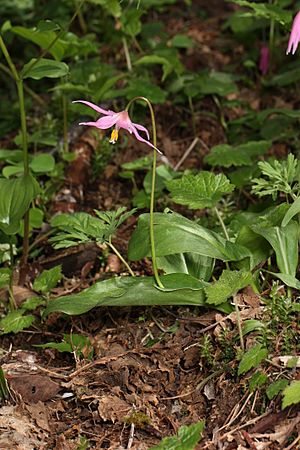Erythronium revolutum facts for kids
Quick facts for kids Erythronium revolutum |
|
|---|---|
 |
|
| Scientific classification | |
| Genus: |
Erythronium
|
| Species: |
revolutum
|
| Synonyms | |
|
Erythronium grandiflorum f. grandiflorum (Sm.) Voss Erythronium grandiflorum var. smithii Hook. Erythronium johnsonii Bol. Erythronium smithii Orcutt |
|
Erythronium revolutum is a beautiful species of flowering plant often called the mahogany fawn lily, coast fawn lily, or pink fawn lily. It belongs to the lily family and grows naturally along the west coast of North America.
Contents
What is the Mahogany Fawn Lily?
This plant is a hardy perennial wildflower, meaning it lives for more than two years and can survive cold weather. It grows from an oval-shaped bulb (like a small onion) that is about 3 to 5 centimeters long. From this bulb, it usually produces two wide, flat, green leaves with interesting mottled patterns, which grow close to the ground.
When Does it Bloom?
The mahogany fawn lily flowers between March and June. Each bulb sends up a long, bare stalk with one or two showy lily-like flowers. The stalk gently bends at the end, so the flower faces towards the ground.
What Do the Flowers Look Like?
Each flower has six tepals, which are like petals and sepals combined. These tepals come in shades of pink or light purple and might have yellow or white spots near the center. As the flower gets older, the tepals often curl back so much that their tips meet behind the flower. The anthers (the parts that hold pollen) are bright yellow.
You can tell Erythronium revolutum apart from similar plants by its pink flowers, its swollen anther filaments (the stalks holding the anthers), and its unique mottled leaves.
What About the Fruit?
After flowering, the plant produces a fruit that is a capsule, which can grow up to 6 centimeters long.
Where Does the Mahogany Fawn Lily Grow?
Erythronium revolutum is native to western North America. You can find it growing from the coast of Northern California all the way up to British Columbia, including Vancouver Island.
Where Does it Like to Live?
This plant is most common within 160 kilometers of the coast, usually at altitudes less than 1,000 meters high. It prefers moist places like along streambanks, in bogs, and in the shady understory of wet redwood and mixed evergreen forests.
It grows slowly, taking about 5 to 7 years for its bulb to become large enough to produce flowers. This means it takes a long time for new plants to establish themselves in new areas.
Are There Any Threats to This Plant?
The natural places where these plants live are sometimes threatened. Also, E. revolutum can be at risk from people collecting them for gardens and from heavy machinery used in forestry, which can compact the soil.
Can You Grow This Plant in a Garden?
Yes, Erythronium revolutum is grown as an ornamental plant in traditional and natural gardens. People like it because of its attractive patterned leaves and its graceful flowers that appear in mid-spring. The best types, sometimes called var. johnstonii, have darker, richer pink flowers and very well-marked leaves.
It should be planted in a shady spot, ideally under deciduous trees or shrubs (trees that lose their leaves in autumn). The soil should be rich in humus (decayed plant matter), stay moist, and be quite damp in spring. Over time, it will spread naturally by dropping its seeds, though this can be a slow process since seedlings take several years to grow big enough to flower.
Images for kids
See also
 In Spanish: Erythronium revolutum para niños
In Spanish: Erythronium revolutum para niños


